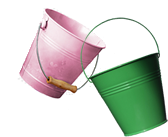Bucket Problems - Addition
Introduction
 When I was young my father used to give me problems to solve, that he said he heard at work that the engineers used to ask each other. One of the problems he gave me he called a bucket problem. I am not sure what the volume of the first bucket problem he gave me, as after I solved the first one, I asked him if he could give me more bucket problems. Of course he did and provided me with several over a period of time.
When I was young my father used to give me problems to solve, that he said he heard at work that the engineers used to ask each other. One of the problems he gave me he called a bucket problem. I am not sure what the volume of the first bucket problem he gave me, as after I solved the first one, I asked him if he could give me more bucket problems. Of course he did and provided me with several over a period of time.
When I say a period of time, I mean extended time: days, weeks, months, ... When dad gave a problem he was really stingy with hints and help. His favorite line was, think about it and if you need a hint, ask me tomorrow. Frustrating, but as the Japanese know the satori for solving a problem is stronger that way.
Anyway, many years later, I remembered the bucket problems and wanted to share some of them with others. Of course I couldn't remember the bucket sizes so I had to try out a few problems to decide what size of buckets I should use for some good problems.
That lead me on an investigation to understand the mathematics behind bucket problems and how solutions would change depending on bucket volume. Below, is a summary of what I have concluded so far. Not sure how complete it is or will be by the time I post this as I believe it can lead to an extensize investigation and proof.
Note: I will use liters, because of all the liter and two liter bottles on store shelves, but any capacity could be used. Dad used gallons.
Bucket problems
Three and Five bucket problem - 1
A person has a three and five liter bucket and needs to measure two liters. How can it be done?
Hint:
- Think subtraction.
- Fill five and dump into three ...
Three and Five bucket problem - 2
A person has a three and five liters bucket and needs to measure four liters. How can it be done?
Hint:
- Make two first.
- Fill five and dump into three ... Have two left in five.
- Dump a bucket full out.
- Empty the three bucket,
- Put the two from the five bucket into the three bucket.
- FIll the five bicket and dump one from it into the three bucket with two.
- Four is left in the five bucket.
Make your own bucket problems
Analysis
If we generate different combinations of buckets, we can use a guess and check strategy to find solutions, if there are any.
Let's start with combinations with one: 1&2, 1&3, 1&4, 1&5, 1&6, ...
- 1 & 2 combinations use ... 1 alone = 1, 2 alone = 2, 1+2=3, 2+2=4, 1+2+2=5. 2+2+2 = 6
- 1 & 3 combinations use ... 1 alone = 1, 3 alone = 3, 1+3=4,
- 1 & 5 combinations use ... 1 alone = 1, 5 alone = 5, 1+5=6, can use one to create any volume.
Conjecture 1. Any combination with a one liter (unit) bucket can be used repeatedly to make any volume.
Next try combinations with two: 2&1 (same as 1&2), 2&3, 2&4, 2&5, 2&6, 2&7, ...
- 2 & 3 combinations use ... pour 3 into 2 and left with 1, 2 alone = 2, 3 alone = 3, 2+2=4 2+3=5, 2+2+2=6, 2+2+3=7,
- 2 & 4 combinations use ... can't make 1, 2 alone = 2, can't make 3, 4 alone = 4, can't make 5, 2+4=6, 2+2+2=6,
Conjecture 2. Any combination with two even liter (unit) buckets can not make any odd volume.